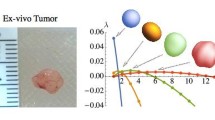Abstract
This paper analyses a recent mathematical model of avascular tumour spheroid growth which accounts for both cell cycle dynamics and chemotactic driven cell movement. The model considers cells to exist in one of two compartments: proliferating and quiescent, as well as accounting for necrosis and apoptosis. One particular focus of this paper is the behaviour created when proliferating and quiescent cells have different chemotactic responses to an extracellular nutrient supply. Two very different steady-state behaviours are identified corresponding to those cases where proliferating cells move either more quickly or more slowly than quiescent cells in response to a gradient in the extracellular nutrient supply. The case where proliferating cells move more rapidly leads to the commonly accepted spheroid structure of a thin layer of proliferating cells surrounding an inner quiescent core. In the case where proliferating cells move more slowly than quiescent cells the model predicts an interesting structure of a thin layer of quiescent cells surrounding an inner core of proliferating and quiescent cells. The sensitivity of this tumour structure to the cell cycle model parameters is also discussed. In particular variations in the steady-state size of the tumour and the types of transient behaviour are explored. The model reveals interesting transient behaviour with sharply delineated regions of proliferating and quiescent cells.
Similar content being viewed by others
References
Baserga, R., Wiebel, F., 1969. The growth of tumor cells under normal and fasting conditions. In: Fry, R., Griem, M., Kirsten, W. (Eds.), Normal and Malignant Cell Growth, vol. 17 of Recent Results in Cancer Research. Springer Verlag, pp. 118–127.
Bonneton, C., Sibarita, J., Thiery, J., 1999. Relationship between cell migration and cell cycle during the initiation of epithelial to fibroblastoid transistion. Cell Mot. Cyto. 43, 288–295.
Byrne, H., Chaplain, M., 1995. Growth of nonnecrotic tumors in the presence and absence of inhibitors. Math. BioSci. 130, 151–181.
Byrne, H., Chaplain, M., 1996. Growth of necrotic tumors in the presence and absence of inhibitors. Math. BioSci. 135, 187–216.
Byrne, H., Gourley, S., 1997. The role of growth factors in avascular tumour growth. Math. Comput. Modell. 26(4), 35–55.
Dorie, M., Kallman, R., Coyne, M., 1986. Effect of cytochalasin b, nocodazole and irradiation on migration and internalization of cells and microspheres in tumor cell spheroids. Exp. Cell Res. 166, 370–378.
Dorie, M., Kallman, R., Rapacchietta, D., van Antwerp, D., Huang, Y., 1982. Migration and internalization of cells and polystrene microspheres in tumor cell spheroids. Exp. Cell Res. 141, 201–209.
Groebe, K., Mueller-Klieser, W., 1991. Distributions of oxygen, nutrient and metabolic waste concentrations in multicellular spheroids and their dependence on spheroid parameters. Eur. Biophys. J. 19, 169–181.
Heppner, G.H., 1984. Perspectives in cancer research: Tumour heterogeneity. Cancer Res. 44, 2259–2783.
Heppner, G.H., Miller, 1989. Therapeutic implications of tumour heterogeneity. Sem. Oncol. 16, 19.
Hughes, F., McCulloch, C., 1991. Quantification of chemotactic response of quiescent and proliferating fibroblasts in boyden chambers by computerassisted image analysis. J. Histochem. Cytochem. 39(2), 243–246.
Jones, A., Byrne, H., Gibson, J., Dodd, J., 2000. A mathematical model of the stress induced during avascular tumour growth. J. Math. Biol. 40, 473–499.
Karbach, U., Gerharz, C., Groebe, K., Gabbert, H., Mueller-Klieser, W., 1992. Rhabdomyosarcoma spheroids with central proliferation and differentiation. Cancer Res. 52, 474–477.
Knuechel, R., Sutherland, R., 1990. Recent developments in research with human tumor spheroids. Cancer J. 3(5), 234–243.
Kunz-Schugart, L., Groebe, K., Mueller-Klieser, W., 1996. Three-dimensional cell culture induces novel proliferative and metabolic alterations associated with oncogenic transformation. Int. J. Cancer 66, 578–586.
Mueller-Klieser, W., 1984. Method for the determination of oxygen consumption rates and diffusion coefficients in multicellular spheroids. Biophys. J. 46, 343–348.
Mueller-Klieser, W., 1997. Three-dimensional cell cultures: From molecular mechanisms to clinical applications. Am. J. Physiol. 273:4(1), 1109–1123.
Palka, J., Adelmann-Grill, B., Francz, P., Bayreuther, K., 1996. Differentiation stage and cell cycle position determine the chemotactic response of fibroblasts. Folia Histochem. Cytobiol. 34(3–4), 121–127.
Pettet, G., Please, C., Tindall, M., McElwain, D., 2001. The migration of cells in multicell tumor spheroids. Bull. Math. Biol. 63(2), 231–257.
Please, C., Pettet, G., McElwain, D., 1998. A new approach to modelling the formation of necrotic regions in tumours. Appl. Math. Lett. 11(3), 89–94.
Sherratt, J., Chaplain, M. (2001). A new mathematical model for avascular tumour growth. J. Math. Biol. 43, 291–312.
Sutherland, R., 1988. Cell and environment interactions in tumor microregions: The multicell spheroid model. Sci. 240, 177–184.
Tindall, M., 2002. Modelling cell movement and the cell cycle in multicellular tumour spheroids. PhD thesis, University of Southampton.
Toro, E., 1989. A weighted average flux method for hyperbolic conservation laws. Proc. R. Soc. Lond. A 423, 401–418.
Toro, E., 1999. Riemann Solvers and Numerical Methods for Fluid Dynamics. Springer Verlag, 2nd edition.
Tubiana, M., 1971. The kinetics of tumour cell proliferation and radiotherapy. Br. J. Radiol. 44, 325–347.
Ward, J., King, J., 1997. Mathematical modelling of avascular tumour growth. IMA J. Math. Appl. Med. Biol. 14(1), 39–69.
Ward, J., King, J., 1998. Mathematical modelling of avascular-tumour growth ii: Modelling growth saturation. IMA J. Math. Appl. Med. Biol. 15, 1–42.
Ward, J., King, J., 2003. Mathematical modelling of drug transport in tumour multicell spheroids and monolayer cultures. Math. BioSci. 181, 177–207.
Author information
Authors and Affiliations
Corresponding author
Rights and permissions
About this article
Cite this article
Tindall, M.J., Please, C.P. Modelling the Cell Cycle and Cell Movement in Multicellular Tumour Spheroids. Bull. Math. Biol. 69, 1147–1165 (2007). https://doi.org/10.1007/s11538-006-9110-z
Received:
Accepted:
Published:
Issue Date:
DOI: https://doi.org/10.1007/s11538-006-9110-z




